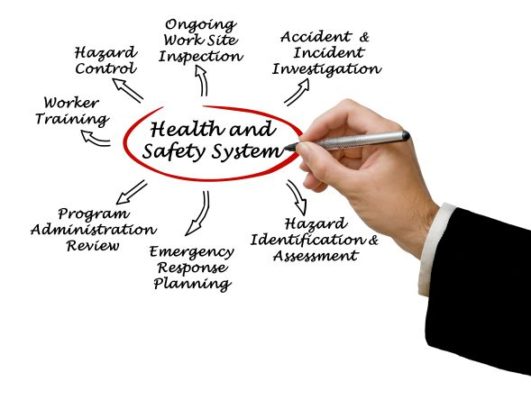Hazard identification risk assessment ensures safety and minimizes potential risks in various industries. It involves the systematic identification, assessment, and mitigation of hazards that may cause harm to individuals, property, or the environment.
This article aims to provide a comprehensive definition of hazard identification risk assessment and its significance in creating a safe working environment.
Hazard identification risk assessment aims to identify potential hazards, evaluate their likelihood and consequences, and implement measures to mitigate or eliminate them.
Organizations must conduct an analysis to prevent accidents, injuries, and damage caused by hazards. It is imperative that they take action to ensure the safety of their employees and the public. Failure to do so could result in severe consequences.
This article will delve into the steps involved in hazard identification risk assessment, including hazard recognition, and assessment of risks associated with identified hazards.
It will also deal with the prioritization of risks based on severity and probability, implementation of control measures to reduce or eliminate risks, and regular monitoring and review of these measures.
Furthermore, it will highlight the importance of proactive risk mitigation by emphasizing preventive actions rather than reactive responses.
Implementing hazard identification risk assessment helps organizations comply with legal requirements and fosters a culture of safety by increasing employee awareness about potential hazards.
Ultimately, this article aims to demonstrate the benefits of implementing hazard identification risk assessments, such as reduced injuries and accident rates and improved regulatory compliance adherence.

The Purpose of Hazard Identification Risk Assessment
Hazard identification risk assessment aims to systematically analyze and evaluate potential hazards that may arise in a given context, allowing for the identification of risks.
Also the development of appropriate control measures to mitigate their impact on human health, safety, and the environment.
This process plays a crucial role in proactive hazard prevention as it enables organizations to identify potential hazards before they occur rather than simply reacting to them after they have already caused harm.
Organizations can reduce the chances and seriousness of accidents or incidents by taking preventive measures based on their knowledge of the risk factors associated with various hazards, such as chemical exposure or equipment failure.
Additionally, hazard identification risk assessment provides a structured approach for evaluating risks across various domains, enabling organizations to prioritize resources and allocate them effectively toward controlling high-risk areas.
It is imperative that we conduct a thorough analysis in order to make well-informed decisions and take appropriate steps to safeguard both people and the environment against any possible risks. Failure to do so could have severe consequences.
Steps Involved in Hazard Identification Risk Assessment
One crucial stage in hazard identification and risk assessment involves systematically analyzing potential dangers and evaluating their likelihood and potential consequences.
This step is essential to identify hazards before they can cause harm and assess the risk level associated with each hazard. The identification process typically involves gathering information through various methods such as observations, interviews, and inspections.
Once hazards are identified, risk assessment techniques are used to determine the level of risk associated with each hazard. These techniques often involve evaluating the likelihood of an incident occurring and assessing the potential consequences if it does happen.
To successfully recognize potential dangers and evaluate the risks associated with them, companies must adhere to these procedures. Only by doing so can they introduce appropriate measures to minimize or eradicate these hazards.
| Identification Process | Risk Assessment Techniques |
|---|---|
| Observations | Quantitative Risk Analysis |
| Interviews | Qualitative Risk Analysis |
| Inspections | SWOT Analysis |
Importance of Proactive Risk Mitigation
Implementing proactive risk mitigation strategies is crucial to effectively reduce the potential negative impacts and consequences that may arise from potential hazards.
Taking proactive measures enables organizations to identify and address risks before they escalate into significant incidents or accidents.
Preventing incidents involves identifying and controlling hazards. Proactive risk mitigation also helps in reducing the severity of an incident if it does occur by implementing safeguards and emergency response plans.
Additionally, it allows organizations to allocate resources efficiently by focusing on high-priority risks and avoiding unnecessary expenses caused by reactive approaches.
Adopting a proactive approach to risk prevention ensures a safer working environment, enhances organizational resilience, and protects both human lives and assets from potential harm.
- Identify potential risks early.
- Implement controls to prevent incidents.
- Allocate resources efficiently.
Creating a Safe Working Environment
Creating a safe working environment is paramount to fostering a sense of security and well-being among individuals, ensuring their productivity and overall satisfaction.
To achieve this, organizations must implement robust safety protocols that effectively identify and mitigate potential hazards.
Regularly conducting hazard identification risk assessments is a crucial step for employers to prevent workplace accidents or injuries. By proactively identifying workplace risks, necessary measures can be taken to ensure the safety of all employees.
This involves evaluating the work environment, equipment, and procedures to identify any potential dangers or deficiencies.
Safety protocols should be comprehensive and cover areas such as emergency response plans, personal protective equipment requirements, and employee training programs.
Implementing these measures reduces the likelihood of workplace accidents and enhances employee morale and job satisfaction by demonstrating an organization’s commitment to their well-being.

Benefits of Implementing Hazard Identification Risk Assessment
An effective hazard identification risk assessment can significantly improve workplace safety and prevent potential accidents or injuries. By implementing this process, organizations can benefit from the following:
- Identification of potential hazards: Conducting a thorough analysis enables businesses to identify and recognize various operational risks.
- Prioritization of risks: The assessment allows prioritizing hazards based on their severity and likelihood, enabling organizations to allocate resources effectively.
- Implementation of risk management strategies: Through hazard identification risk assessments, companies can develop and implement appropriate risk management strategies to mitigate identified hazards.
- Compliance with regulations: This process ensures that organizations comply with relevant safety regulations and standards, reducing the potential for legal issues or penalties.
- Improved workplace safety measures: Regular hazard identification risk assessments emphasize workplace safety, leading to safer working conditions for employees.
Frequently Asked Questions
What are the common techniques used for hazard identification in risk assessment?
Common risk identification techniques include brainstorming, checklists, fault tree analysis, and job hazard analysis.
Hazard identification is crucial as it helps identify potential dangers and prevent accidents or incidents.
How often should hazard identification risk assessments be conducted in a workplace?
Hazard identification risk assessments should be conducted regularly in the workplace to ensure the frequency of evaluations aligns with the dynamic nature of hazards.
This is important as it allows for timely identification and mitigation of risks, contributing to overall safety and prevention measures.
What examples of potential hazards can be identified through risk assessment?
Examples of potential hazards that can be identified through risk assessment are chemical exposure, machinery malfunctions, ergonomic issues, slips and trips, and electrical hazards.
Identifying these hazards is important for maintaining a safe workplace environment.
What is the role of employees in the hazard identification risk assessment process?
Employee involvement is crucial in hazard identification risk assessment due to their firsthand knowledge of workplace operations.
Their active participation and communication are vital in identifying potential hazards and implementing effective risk management strategies.
Are there any legal requirements or regulations that mandate hazard identification risk assessments in certain industries?
Legal implications and industry regulations often mandate hazard identification risk assessments in certain industries.
These requirements ensure that organizations proactively identify and assess potential hazards, thus minimizing risks to the health and safety of employees and the public.

Conclusion
It is imperative that hazard identification and risk assessment be conducted to ensure a safe work environment.
Organizations can create a safe working environment for their employees by identifying potential hazards systematically and assessing their risks. This approach allows them to take proactive measures to mitigate any risks.
Implementing hazard identification risk assessment has numerous benefits, including reducing accidents and injuries, improving productivity, and enhancing the overall well-being of employees.
Organizations can effectively manage hazards and protect their workforce from potential harm by following the steps involved in this process and prioritizing proactive risk mitigation.

Chris Ekai is a Risk Management expert with over 10 years of experience in the field. He has a Master’s(MSc) degree in Risk Management from University of Portsmouth and is a CPA and Finance professional. He currently works as a Content Manager at Risk Publishing, writing about Enterprise Risk Management, Business Continuity Management and Project Management.

